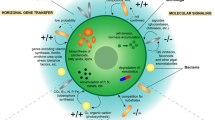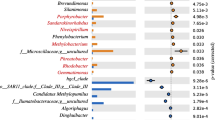Abstract
Magnetotactic bacteria, for the most part, are free-living, motile, unicellular prokaryotes that inhabit almost all marine and freshwater environments. One notable exception to the unicellular mode, however, are the magnetotactic multicellular prokaryotes. These morphologically unique prokaryotes (e.g., Candidatus Magnetoglobus multicellularis) are motile aggregates of 20–40 genetically identical, Gram-negative cells organised as a sphere (or ovoid in shape) and only motile as a unit. No specific close physical association between magnetotactic bacteria and non-magnetotactic microorganisms has ever been reported. Here, using culture-independent approaches, we show an unusual association between the spherical magnetotactic multicellular prokaryote Ca. Magnetoglobus multicellularis and Pseudoalteromonas species in environmental sediment and water samples collected from the Araruama Lagoon in Brazil. Cells of Pseudoalteromonas species were observed to be physically attached to the surface and, notably, even in the intercellular space of these spherical magnetotactic multicellular prokaryotes. An attempt to correlate the frequency of association between Pseudoalteromonas and magnetotactic multicellular prokaryotes with sediment depth was made but only a slight decrease in the number of Pseudoalteromonas cells per magnetotactic multicellular prokaryote was observed with increasing depth. Similar observations were made with magnetotactic multicellular prokaryotes from another Brazilian Lagoon (Rodrigo de Freitas) and the putative symbiont/parasite was detected. Although our results suggest some sort of specificity in the relationship between these prokaryotes, the precise nature of this association remains unclear.





Similar content being viewed by others
References
Abreu F, Silva KT, Martins JL, Lins U (2006) Cell viability in magnetotactic multicellular prokaryotes. Int Microbiol 9:267–272
Abreu F, Martins JL, Silveira TS, Keim CN, Lins de Barros HGP, Gueiros-Filho F, Lins U (2007) ‘Candidatus Magnetoglobus multicellularis’, a multicellular magnetotactic prokaryote from a hypersaline environment. Int J Syst Evol Microbiol 57:1318–1322. https://doi.org/10.1099/ijs.0.64857-0
Abreu F, Silva KT, Farina M, Keim CN, Lins U (2008) Greigite magnetosome membrane ultrastructure in ‘Candidatus Magnetoglobus multicellularis’. Int Microbiol 11:75–80. https://doi.org/10.2436/20.1501.01.46
Abreu F, Cantão ME, Nicolás MF, Barcellos FG, Morillo V, Almeida LG et al (2011) Common ancestry of iron oxide- and iron-sulfide-based biomineralization in magnetotactic bacteria. ISME J 5:1634–1640. https://doi.org/10.1038/ismej.2011.35
Abreu F, Silva KT, Leão P, Guedes IA, Keim CN, Farina M, Lins U (2013) Cell adhesion, multicellular morphology, and magnetosome distribution in the multicellular magnetotactic prokaryote Candidatus Magnetoglobus multicellularis. Microsc Microanal 19:535–543. https://doi.org/10.1017/S1431927613000329
Abreu F, Morillo V, Nascimento FF, Ribeiro CW, Cantão ME, Ciapina LP et al (2014) Deciphering unusual uncultured magnetotactic multicellular prokaryotes through genomics. ISME J 8:1055–1068. https://doi.org/10.1038/ismej.2013.203
Altschul SF, Gish W, Miller W, Myers EW, Lipman DJ (1990) Basic local alignment search tool. J Mol Biol 215:403–410. https://doi.org/10.1016/S0022-2836(05)80360-2
Bazylinski DA, Frankel RB (2004) Magnetosome formation in prokaryotes. Nat Rev Microbiol 2:217–230. https://doi.org/10.1038/nrmicro842
Bazylinski DA, Lefèvre CT (2013) Magnetotactic bacteria from extreme environments. Life 3:295–307. https://doi.org/10.3390/life3020295
Bazylinski DA, Schlezinger DR, Howes BH, Frankel RB, Epstein SS (2000) Occurrence and distribution of diverse populations of magnetic protists in a chemically-stratified coastal salt pond. Chem Geol 169:319–328. https://doi.org/10.1016/S0009-2541(00)00211-4
Berleman JE, Kirby JR (2007) Multicellular development in Myxococcus xanthus is stimulated by predator-prey interactions. J Bacteriol 189:5675–5682. https://doi.org/10.1128/JB.00544-07
Boetius A, Ravenschlag K, Schubert CJ, Rickert D, Widdel F, Gieseke A et al (2000) A marine microbial consortium apparently mediating anaerobic oxidation of methane. Nature 407:623–626. https://doi.org/10.1038/35036572
Bowman JP (2007) Bioactive compound synthetic capacity and ecological significance of marine bacterial genus Pseudoalteromonas. Mar Drugs 5:220–241. https://doi.org/10.3390/md504220
Bowman JP, McMeekin TA (2015) Alteromonadaceae. Bergey’s manual of systematics of archaea and bacteria, pp 1–2
Boyd A, Chakrabarty AM (1994) Role of the alginate lyase in cell detachment of Pseudomonas aeruginosa. Appl Environ Microbiol 60:2355–2359
Chen AP, Berounsky VM, Chan MK, Blackford MG, Cady C, Moskowitz BM et al (2014) Magnetic properties of uncultivated magnetotactic bacteria and their contribution to a stratified estuary iron cycle. Nat Commun 5:4797. https://doi.org/10.1038/ncomms5797
Chen YR, Zhang R, Du HJ, Pan HM, Zhang WY, Zhou K et al (2015) A novel species of ellipsoidal multicellular magnetotactic prokaryotes from Lake Yuehu in China. Environ Microbiol 17:637–647. https://doi.org/10.1111/1462-2920.12480
Dufour SC, Laurich JR, Batstone RT, McCuaig B, Elliott A, Poduska KM (2014) Magnetosome-containing bacteria living as symbionts of bivalves. ISME J 8:2453–2462. https://doi.org/10.1038/ismej.2014.93
Enger O, Nygaard H, Solberg M, Schei G, Nielsen J, Dundas I (1987) Characterization of Alteromonas denitrificans sp. nov. Int J Syst Bacteriol 37:416–421. https://doi.org/10.1099/00207713-37-4-416
Fuchs BM, Wallner G, Beisker W, Schwippl I, Ludwig W, Amann R (1998) Flow cytometric analysis of the in situ accessibility of Escherichia coli 16S rRNA for fluorescently labeled oligonucleotide probes. Appl Environ Microbiol 64:4973–4982
Gast RJ, Sanders RW, Caron DA (2009) Ecological strategies of protists and their symbiotic relationships with prokaryotic microbes. Trends Microbiol 17:563–569. https://doi.org/10.1016/j.tim.2009.09.001
Grossart HP (1999) Interactions between marine bacteria and axenic diatoms (Cylindrotheca fusiformis, Nitzschia laevis, and Thalassiosira weissflogii) incubated under various conditions in the lab. Aquat Microb Ecol 19:1–11. https://doi.org/10.3354/ame019001
Gupta P, Diwan B (2017) Bacterial exopolysaccharide mediated heavy metal removal: a review on biosynthesis, mechanism and remediation strategies. Biotechnol Rep 13:58–71. https://doi.org/10.1016/j.btre.2016.12.006
Hall TA (1999) BioEdit: a user-friendly biological sequence alignment editor and analysis program for Windows 95/98/NT. In: Nucleic acids symposium series, vol 41, pp 95–98
Hassler CS, Alasonati E, Nichols CAM, Slaveykova VI (2011) Exopolysaccharides produced by bacteria isolated from the pelagic Southern Ocean-Role in Fe binding, chemical reactivity, and bioavailability. Mar Chem 123:88–98. https://doi.org/10.1016/j.marchem.2010.10.003
Holmström C, Kjelleberg S (1999) Marine Pseudoalteromonas species are associated with higher organisms and produce biologically active extracellular agents. FEMS Microbiol Ecol 30:285–293. https://doi.org/10.1111/j.1574-6941.1999.tb00656.x
Holmström C, James S, Neilan BA, White DC, Kjelleberg S (1998) Pseudoalteromonas tunicata sp. nov., a bacterium that produces antifouling agents. Int J Syst Bacteriol 4:1205–1212. https://doi.org/10.1099/00207713-48-4-1205
Holmström C, Egan S, Franks A, McCloy S, Kjelleberg S (2002) Antifouling activities expressed by marine surface associated Pseudoalteromonas species. FEMS Microbiol Ecol 41:47–58. https://doi.org/10.1111/j.1574-6941.2002.tb00965.x
James S, Holmström C, Kjelleberg S (1996) Purification and characterization of a novel antibacterial protein from the marine bacterium D2. Appl Environ Microbiol 62:2783–2788
Keim CN, Martins JL, Abreu F, Rosado AS, Lins de Barros HGP, Borojevic R et al (2004) Multicellular life cycle of magnetotactic prokaryotes. FEMS Microbiol Lett 240:203–208. https://doi.org/10.1016/j.femsle.2004.09.035
Kumar S, Stecher G, Tamura K (2016) MEGA7: molecular evolutionary genetics analysis version 7.0 for bigger datasets. Mol Biol Evol 33:1870–1874. https://doi.org/10.1093/molbev/msw054
Lane DJ (1991) 16S/23S rRNA sequencing. In: Stackebrandt E, Goodfellow M (eds) Nucleic acid techniques in bacterial systematics. Wiley, New York, pp 115–175
Lins U, Freitas F, Keim CN, Lins de Barros H, Esquivel DMS, Farina M (2003) Simple homemade apparatus for harvesting uncultured magnetotactic microorganisms. Braz J Microbiol 34:111–116. https://doi.org/10.1590/S1517-83822003000200004
Martins JL, Silveira TS, Abreu F, Silva KT, Silva-Neto ID, Lins U (2007) Grazing protozoa and magnetosome dissolution in magnetotactic bacteria. Environ Microbiol 9:2775–2781. https://doi.org/10.1111/j.1462-2920.2007.01389.x
Martins JL, Silveira TS, Silva KT, Lins U (2009) Salinity dependence on the distribution of multicellular magnetotactic prokaryotes in the hypersaline Araruama lagoon, Brazil. Int Microbiol 12:193–201. https://doi.org/10.2436/20.1501.01.98
Muller F, Brissac T, Le Bris N, Felbeck H, Gros O (2010) First description of giant Archaea (Thaumarchaeota) associated with putative bacterial ectosymbionts in a sulfidic marine habitat. Environ Microbiol 12:2371–2383. https://doi.org/10.1111/j.1462-2920.2010.02309.x
Offret C, Desriac F, Le Chevalier P, Mounier J, Jégou C, Fleury Y (2016) Spotlight on antimicrobial metabolites from the marine bacteria Pseudoalteromonas: chemodiversity and ecological significance. Mar Drugs 14(7):129. https://doi.org/10.3390/md14070129
Pruesse E, Quast C, Knittel K, Fuchs BM, Ludwig W, Peplies J, Glöckner FO (2007) SILVA: a comprehensive online resource for quality checked and aligned ribosomal RNA sequence data compatible with ARB. Nucleic Acids Res 35:7188–7196. https://doi.org/10.1093/nar/gkm864
Qin GK, Zhu LZ, Chen XL, Wang PG, Zhang YZ (2007) Structural characterization and ecological roles of a novel exopolysaccharide from the deep-sea psychrotolerant bacterium Pseudoalteromonas sp. SM9913. Microbiology 153:1566–1572. https://doi.org/10.1099/mic.0.2006/003327-0
Reitner J, Peckmann J, Blumenberg M, Michaelis W, Reimer A, Thiel V (2005) Concretionary methane-seep carbonates and associated microbial communities in Black Sea sediments. Palaeogeogr Palaeoclimatol 227:18–30. https://doi.org/10.1016/j.palaeo.2005.04.033
Sawabe T, Makino H, Tatsumi M, Nakano K, Tajima K, Iqbal MM et al (1998) Pseudoalteromonas bacteriolytica sp. nov., a marine bacterium that is the causative agent of red spot disease of Laminaria japonica. Int J Syst Bacteriol 48:769–774. https://doi.org/10.1099/00207713-48-3-769
Schink B (2002) Synergistic interactions in the microbial world. Antonie Van Leeuwenhoek 81:257–261. https://doi.org/10.1023/A:1020579004534
Simmons SL, Edwards KJ (2006) Geobiology of magnetotactic bacteria. In: Schüler D (ed) Magnetoreception and magnetosomes in bacteria. Microbiology monographs (3). Springer, Berlin, pp 77–102
Techkarnjanaruk S, Pongpattanakitshote S, Goodman A (1997) Use of a promoterless lacZ gene insertion to investigate chitinase gene expression in the marine bacterium Pseudoalteromonas sp. strain S9. Appl Environ Microbiol 63:2989–2996
Thomas T, Evans FF, Schleheck D, Mai-Prochnow A, Burke C, Penesyan A et al (2008) Analysis of the Pseudoalteromonas tunicata genome reveals properties of a surface-associated life style in the marine environment. PLoS ONE 3:e3252. https://doi.org/10.1371/journal.pone.0003252
Wang Q, Garrity GM, Tiedje JM, Cole JR (2007) Naïve Bayesian classifier for rapid assignment of rRNA sequences into the new bacterial taxonomy. Appl Environ Microbiol 73:5261–5267. https://doi.org/10.1128/AEM.00062-07
Wanner G, Vogl K, Overmann J (2008) Ultrastructural characterization of the prokaryotic symbiosis in ‘Chlorochromatium aggregatum’. J Bacteriol 190:3721–3730. https://doi.org/10.1128/JB.00027-08
Winklhofer M, Abraçado LG, Davila AF, Keim CN, Lins de Barros HGP (2007) Magnetic optimization in a multicellular magnetotactic organism. Biophys J 92:661–670. https://doi.org/10.1529/biophysj.106.093823
Wrede C, Kokoschka S, Dreier A, Heller C, Reitner J, Hoppert M (2013a) Deposition of biogenic iron minerals in a methane oxidizing microbial mat. Archaea 2013:102972. https://doi.org/10.1155/2013/102972
Wrede C, Krukenberg V, Dreier A, Reitner J, Heller C, Hoppert M (2013b) Detection of metabolic key enzymes of methane turnover processes in cold seep microbial biofilms. Geomicrobiol J 30:214–227. https://doi.org/10.1080/01490451.2012.665150
Zhou K, Zhang WY, Yu-Zhang K, Pan HM, Zhang SD, Zhang WJ et al (2012) A novel genus of multicellular magnetotactic prokaryotes from the Yellow Sea. Environ Microbiol 14:405–413. https://doi.org/10.1111/j.1462-2920.2011.02590.x
Acknowledgements
We acknowledge financial support from the Brazilian agencies Conselho Nacional de Desenvolvimento Científico e Tecnológico (CNPq), Coordenação de Aperfeiçoamento de Pessoal de Nível Superior (CAPES) and Fundação de Amparo à Pesquisa do Estado do Rio de Janeiro (FAPERJ) agencies. D.A.B. is supported by U.S. National Science Foundation grant EAR-1423939. Microscopy Facilities: Unidade de Microscopia Multiusuário Souto-Padrón & Lins (UniMicro, UFRJ) and Centro Nacional de Biologia Estrutural e Bioimagem (CENABIO, UFRJ).
Author information
Authors and Affiliations
Corresponding author
Ethics declarations
Conflict of interest
The authors declare that they have no conflict of interest.
Electronic supplementary material
Below is the link to the electronic supplementary material.
Figure S1
Scanning electron microscopy of multicellular magnetotactic prokaryotes from Araruama and Rodrigo de Freitas lagoons, Rio de Janeiro, Brazil
Rights and permissions
About this article
Cite this article
Leão, P., Gueiros-Filho, F.J., Bazylinski, D.A. et al. Association of magnetotactic multicellular prokaryotes with Pseudoalteromonas species in a natural lagoon environment. Antonie van Leeuwenhoek 111, 2213–2223 (2018). https://doi.org/10.1007/s10482-018-1113-x
Received:
Accepted:
Published:
Issue Date:
DOI: https://doi.org/10.1007/s10482-018-1113-x




